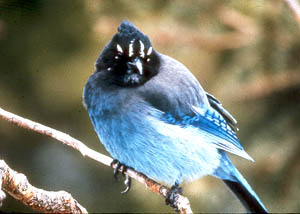September 98 Mystery Birds
Thanks again to all those who bravely contributed public comments, opinions and speculation.
The jay is clearly some form of Steller's Jay. North American populations can be divided into two subspecies
groups. Those on the Pacific Coast and Sierra have blue streaks on the crest, but those in the Rocky Mountains
(C.s. macrolopha) have white streaks instead. This bird was photographed in Colorado so it should be representative
of that population. In addition there are a number of races in Middle America which have shorter bluer crests and
back and this bird shows some similarities to those birds. However the short appearing crest is partly an illusion
caused by the angle at which the photo was taken. See below.
Those familiar with Steller's Jays on the West Coast may also notice the unexpected small white throat patch
 and a trace of a gray band across the breast.
These seem to point to the possibility of Steller's X Blue Jay, hybrids of which have been documented from Colorado.
In fact that was my first conclusion. But I now see those same features in a photo of a non-hybrid Steller's Jay
on page 557 of "Birds of Colorado" by Bailey and Niedrach (1965).
and a trace of a gray band across the breast.
These seem to point to the possibility of Steller's X Blue Jay, hybrids of which have been documented from Colorado.
In fact that was my first conclusion. But I now see those same features in a photo of a non-hybrid Steller's Jay
on page 557 of "Birds of Colorado" by Bailey and Niedrach (1965).
So I am left with nothing concrete to pin a hybrid identification on. This additional photo of this individual
shows a long dark looking crest which is lying flat as seen above. I would expect a true hybrid to show more unambiguous
Blue Jay characters such as a white wing-bar or white belly.. Of course it is always possible that it could be
a second or third generation hybrid backcross, but I don't think there is enough information in the photos to say
for sure.
It would be helpful to get comments from people living in Colorado or elsewhere within the range of Rocky Mountain
Steller's Jays to see if they think this bird is outside normal variation. The Public Comment page remains open
for feedback on any of these mystery birds, old or new.
The sparrow is definitely a Grasshopper Sparrow in fresh early winter plumage. Although it has a superficial
resemblance to a Le Conte's Sparrow, the gray face patch is in the wrong place. On Le Conte's the ear coverts are
gray, on Grasshopper it is the rear of the supercilium which is gray. There are other differences of course, but
that's the one which is least subject to misinterpretation.
Several contributors commented that the bill was too small and the tail too long for Grasshopper Sparrow, but
the tail looks relatively short to me and Grasshopper Sparrows I see in California look to be smaller billed than
those in the East. Also young birds definitely have smaller bills than adults in this species. Nevertheless, it's
easy to see how a single photograph can be misleading and why it is so important to include a description of the
bird along with photographs when documenting rarities. Photos by themselves are helpful, but there have been many
cases where a few lines of description would have saved records committees many hours of agonizing deliberation.
This Grasshopper Sparrow was photographed at Deep Springs College in Inyo County in October 1972.
 |

|
| This is one of North America's most strikingly beautiful birds. Photograph by Mike Wihler. Click on the image to
view full size. |
Here another puzzler. Photograph by Gary Zamzow. More subdued but striking in its own way. Click on the image to
view full size. |
What do you think these birds are? Please click here
to view comments or add your own. Thank you very much for contributing your thoughts.
[Home] [California Birding]
 and a trace of a gray band across the breast.
These seem to point to the possibility of Steller's X Blue Jay, hybrids of which have been documented from Colorado.
In fact that was my first conclusion. But I now see those same features in a photo of a non-hybrid Steller's Jay
on page 557 of "Birds of Colorado" by Bailey and Niedrach (1965).
and a trace of a gray band across the breast.
These seem to point to the possibility of Steller's X Blue Jay, hybrids of which have been documented from Colorado.
In fact that was my first conclusion. But I now see those same features in a photo of a non-hybrid Steller's Jay
on page 557 of "Birds of Colorado" by Bailey and Niedrach (1965).
